Sundials, astrolab clocks, and much more, the whole of time is represented in Chartres Cathedral, from the north porch to the south porch, from the Creation of the World to the Last Judgment, from Alpha to Omega…
How is time measured in the cathedral, how is the day divided up…?
Extract from a lecture given by the Cathedral’s Visits & Welcome Service as part of its Spring 2023 Cycle.
The astrolabic clock
And the year? It comes from a Latin word meaning “ring”, a complete circle.
The year is a major unit of time, with a complete plant cycle. By 3000 BC, the Egyptians had already established a calendar almost identical to our own. However, the year was a quarter of a day too short. An insignificant difference, but one that increased from year to year… Julius Caesar decided to reform the calendar in 46 BC, hence the name Julian calendar. The year begins on January 1; Julius Caesar introduced the leap year, every four years, twice on the sixth day (bis-sextile) before the March calendar. A quarter of an hour less each year. It was a veritable revolution, and a remarkably effective one! For 16 centuries, Europe would live on the time of the Julian calendar.
But the year was still a few seconds too long. In the 16th century, the Gregorian calendar was introduced, named after Pope Gregory XIII. In the papal bull “inter gravissimas” signed on February 24, 1582, he decided to subtract 10 days from the calendar. His decision was based on the work of astronomers, and reaffirmed the Church’s power over time. By pontifical decision, in Rome, Thursday October 4, 1582 was followed by Friday October 15, 1582.
In Russia, the Bolshevik revolution of 1917 put an end to the Julian calendar.
Today, the Gregorian calendar is the universal world reference.
In the Middle Ages, the Julian calendar was still used.
But how do you measure time…?
The astrolabic or astronomical clock dates back to around 1407. In Chartres, it was inserted into the choir tower in the early 16th century, and restored in 2008.
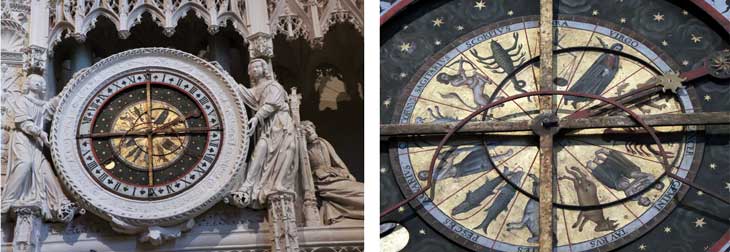
Even the house of The Eternal is subject to earthly time. Time that is more than precious… Chartres Cathedral boasts one of France’s oldest astrolabic clocks, inserted into one of the south bays of the choir tower. Very rare in the Middle Ages, they were the work of highly talented scientists.
We don’t know who made the one in Chartres, but it and the one in Bourges (1424) are the only two surviving examples of this type in the world.
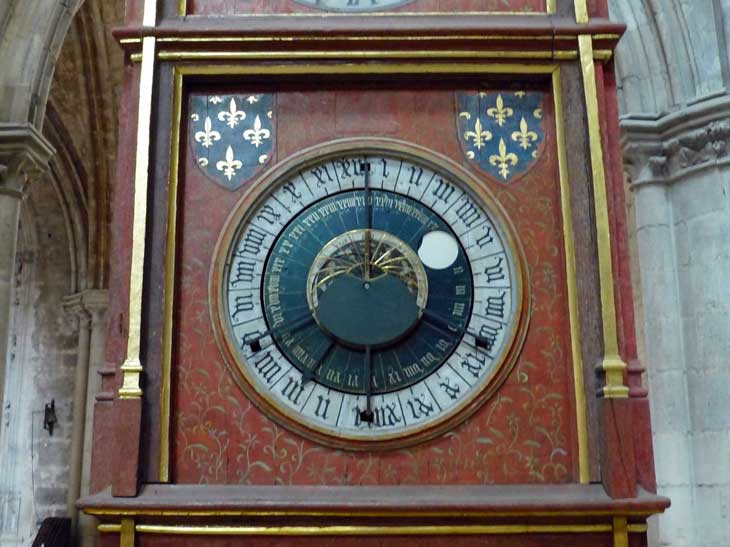
The Bourges astrolabic clock (1424) is, along with the Chartres clock, one of only two surviving examples of this type in the world.
From the very beginning of the 15th century, it was mentioned in 1407 in a chapter deliberation of the cathedral chapter. Its presence was a way for the chapter to show that they were at the cutting edge of progress. But it was also used for liturgical purposes, such as Easter, on feast days that vary according to the moon’s cycle. In the Middle Ages, measuring time was essential to the organization of religious life.
The first mechanical clocks featured a single hand, the hour hand. But astrolab clocks not only tell the time, they also reproduce the annual movements of the Sun and Moon.
Indeed, as seen from the Earth, there are two major star cycles that humans observe: that of the Moon and that of the Sun.
The lunar calendar is based on the month. Each month begins with a first quarter, which occurs approximately every 29 and a half days.
The solar calendar is based on the seasons. The year during which the Earth makes a complete orbit around the Sun, marked by two equinoxes and two solstices, is divided into four seasons. There is an 11-day difference between the lunar and solar years.
This type of clock can therefore also be used to determine the date of Easter and eclipses. It also betrays a definite interest in astronomy on the part of the canons.
Ptolemy, along with astronomy, is one of the liberal arts featured in the Royal Portal. This interest is confirmed by the many representations of zodiacs in the cathedral, particularly the Zodiac stained-glass window opposite the clock.
The astrolabic clock is presented in a carved stone medallion. The dial is carried by two angels; a third, broken, gripped the dial from below. Above the medallion, the bay window is openwork. Restoration of the polychromy has restored it to its former glory. The careful polychromy shows the scrolling phases of the Moon and the signs of the zodiac – here’s our fifth zodiac.
The dial shows:
– the 24 hours of the day,
– the lunar day,
– the signs of the zodiac painted on a disc indicating the sun’s elliptical path.
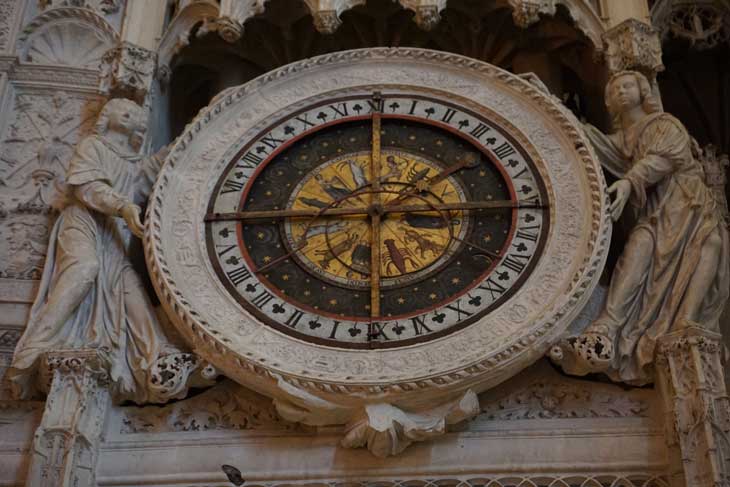
Around the choir, clock face © A. Gouache
At the rear, a set of pinions and cogwheels transmitted the driving force to the dials. Bells were suspended from the niche’s vault, and the mechanism caused them to chime.
The complexity of this mechanism required regular maintenance. It required such fine-tuning that by the mid-17th century, it became difficult to find a specialist to maintain it.
The mechanism was therefore abandoned, before being largely destroyed in 1793. The bronze from the bells was turned into cannon, and the iron from the clock movement was used to forge pikes.
The dial measures 1.05 m. It consists of four independent copper-alloy plates, assembled on a central axis.
1/ the hour dial shows the 24 hours separated by clovers. It features a single hand to mark the hours.
2/ the moon dial features gold stars on an azure background. It is mobile and makes one revolution in one lunar day. It has a viewing hole.
3/ an intermediate sundial showing the different phases of the Moon in the Chartres sky.
4/ the zodiac dial shows the movement of the Sun and the signs of the zodiac. This intermediate disk is adorned with the names and figures of the twelve signs of the zodiac. These signs are framed within a 30-degree arc (12 x 30 = 360°). To find out which sign the Sun was in, all you had to do was see which sign was passing under the Sun’s large needle.
The arched line fixed to the dial is the Chartres horizon.
The Chartres clock was manually reset every noon, using the sundials, and from the 17th century onwards, using the meridian installed in 1701.
Restored in 2008, the Chartres astrolabic clock, equipped with an electrified mechanism, has been ticking away time again since 2010. The restoration brought the clock back to life, and gave us a better idea of the difficulties encountered by the builders, as well as their astonishing scientific and technical capabilities.
The clock pavilion
Another clock on the North side, which dates back to 1392 (a primitive mechanism built in 1370 by Henri de Vic and equipped with a striking mechanism in the late 14th century), was sheltered at the foot of the North tower, in the clock pavilion (a pavilion built by Jehan de Beauce in 1520; its base is purportedly a reuse from the 13th century).
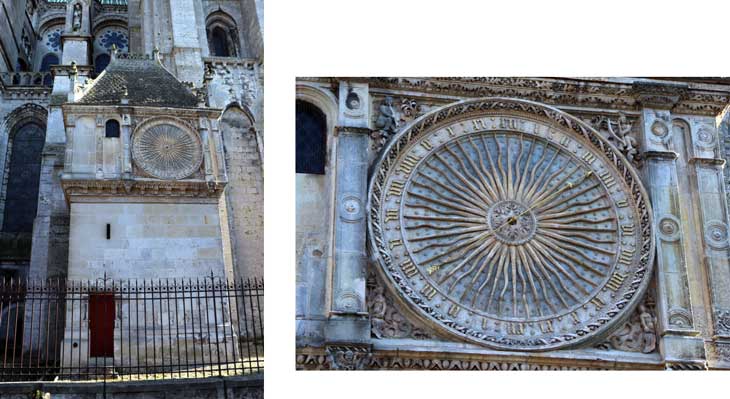
This clock was operated by ‘le timbre’ (the bell of the civil clock) which strikes the hours at the top of the new bell tower. It is the timbre from this period that still rings. According to a June 24, 1865 article by archaeologist Adolphe Lecocq (“Notice historique et archéologique sur les horloges de l’église Notre-Dame de Chartres”, in Mémoires de la société archéologique d’Eure-et-Loir, tome IV, Chartres, 1867, pp. 284-340), two dates are engraved on one side of the wooden frame containing the gears: 1556 and 1576, and would correspond to a more recent clock from the 16th century.
A project to bring the clock back into operation is currently under study, but will require electrification of the pavilion.
Bells in Chartres Cathedral
It’s impossible to talk about time in the Cathedral without mentioning the bells. They tell the time and punctuate events in the sanctuary – masses, weddings, funerals.
Before the revolution, the old bell tower was home to six bells, including three bourdon-type bells. The largest were Marie (15 tons) and Gabrielle (10 tons). Around 1793-1794, these bells were used to melt cannons or make pennies…
The Revolution left only two bells in the new bell tower: “le timbre”, still in place in the lantern, which told the time and served as a tocsin; and another bell for services. The latter disappeared in a fire on June 4, 1836. The fire, which consumed the entire roof structure, spread to the belfries of the old and new bell towers. Fortunately, the fire stopped before it reached the lantern, preserving the bell which continued to ring during the fire.
Four years after the fire, two new bells were installed in 1840, and four more in 1845.
Today, the new bell tower has seven bells: the six 19th-century bells and the timbre.
The oldest bell in the cathedral today is the timbre, which rings the hours with the note A.
It has no clapper and is struck by two stone hammers on the bell’s outer shell. Weighing 5 tons, it measures 1.92 m in diameter. It went into operation on September 23, 1520.
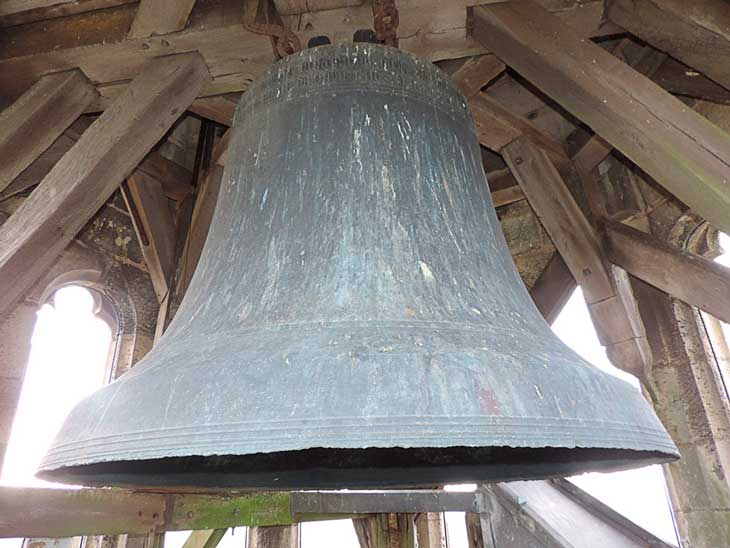
Bell of the civil clock (“le timbre”) – Notre-Dame de Chartres cathedral.
The founder’s name was Pierre Savyet, “founder of bells and cannons for the Navy” in Boulogne-sur-Mer; he was to take as his model “the bell of the palace clock in Paris”.
In relief, it bears the image of the Drap d’Or camp, where François 1er and Henry VIII, King of England, made a perpetual alliance on July 7, 1520.
Since the 1990s, it has been struck by two electronically-controlled hammers.
Until 1887, the clock was struck by a single hammer, set in motion by a series of rods connected to the bell.
Discover our article presenting all the cathedral’s bells
Extract from a talk given by Christine Afota and Georges Athanassiadis, guides at the Cathedral’s Visitor Service, as part of the Cycles thématiques (Printemps 2023).